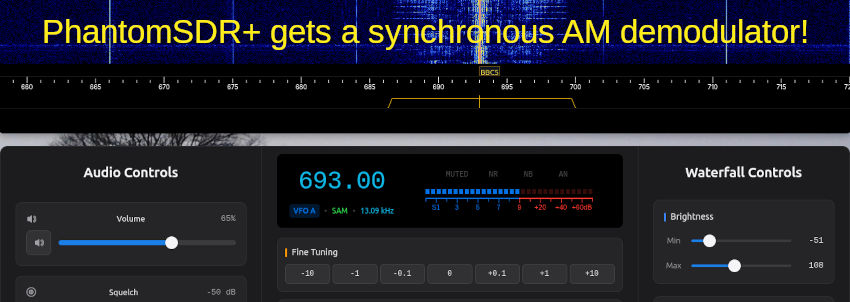 Listen for some
synchronously demodulated music from the Heppen Belgium internet SDR.
Listen for some
synchronously demodulated music from the Heppen Belgium internet SDR.
Press and hold the "AM" button, then select "SAM" mode.
PhantomSDR+ users who enjoy listening to shortwave broadcasts, or perhaps some AM talk radio shows around the world, will be happy to find that they can now use a synchronous detector, also called a synchronous demodulator, to get improved sound quality. I have been tuning around my favorite music stations in the "European rock and roll window" around 6100 kHz and the results are stellar.
This is a big deal, because life is too short for listening to crappy distorted signals. When conditions are noisy, or with a lot of fading, conventional AM demodulation really takes a beating, although it is possible to listen through the junk by using upper or lower sideband. Manually tuning the receiver to zero-beat the AM carrier is tedious, but necessary if listening to musical programming.
Listening on an envelope demodulator, stations become distorted during deep fades, as the demodulator has what engineers call a "square law" response. It is no good when the carrier wave is lost in the background noise, or is too weak in relation to the sidebands. Distortion can be even worse if there is interference on the desired station from other carrier waves or signals on adjacent frequencies.
Sync demodulators have an advantage over conventional "envelope" demodulators, as they are less subject to distortion as stations fade up and down during changing radio propagation conditions. The key is being able to accurately sense the proper frequency and phase of the station's carrier wave and then account for that in demodulating the upper and lower sidebands.
In hardware radios, a strong and steady oscillator would be tuned to exactly match the frequency and phase of the received signal's carrier. That locally generated, carrier would be mixed with the actual signal, producing the desired audio output. In DSP the operation is essentialy a multiplication of the tuned signal with the computed values of a virtual synthetic carrier. The product is the demodulated audio.
As a radio operator, you have an easy task when listening to AM radio on a synchronous demodulator. Just tune in the desired station and select "SAM" mode. On a PhantomSDR+ site, click and hold the "AM" button, then select "SAM" from the pop-up which appears.
PhantomSDR+ is the advanced, massively multi-listener radio server for sharing shortwave, mediumwave, and other signals over the internet. It is an open source type of WebSDR and works with a great many types of hardware: RTL-SDR, Airspy, SDRplay. Really, if it works with SoapySDR, it ought to work with PhantomSDR+. For a full list of receivers on all bands, from VLF through light, visit http://sdr-list.xyz.
© 2015 - 2025 Skywavelinux.com, All Rights Reserved. Written and curated by Webmaster - Developer Philip Collier Contact, Privacy Policy and Disclosures, XML Sitemap.